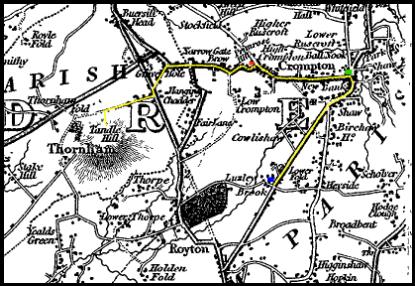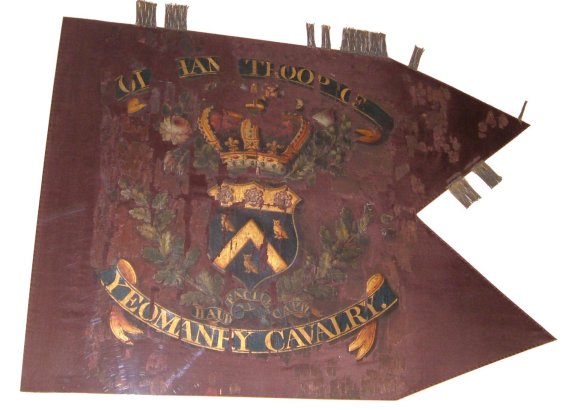
The history of Oldham Cavalry Volunteers dates back to 1798 when on the 17 April a meeting was held in Oldham to raise money to equip and clothe two bodies of volunteers. 1798 was a year of great concern throughout the Kingdom, the French, who were engaged in building up fleets of barges in preparation for the invasion of England, caused the Government to contemplate arming every able-bodied man in the Kingdom and a great many “Armed Associations” were formed throughout the country, including Oldham. The mounted volunteers were known as the Oldham Horse Association and were commanded by a Mr Ralph Kershaw.
The Government, worried by the lack of organisation and training of the Yeomanry, introduced new regulations in 1816 that required six days paid training per year during peacetime. This was supposed to be only for Yeomanry regiments of three or more troops. However this was largely ignored in Lancashire, when in 1817 the “Oldham Troop of Yeomanry Cavalry” was formed consisting of only one troop of initially, according to the first returns for 1817, only 28 men. In 1818 this had increased to 37 men and by 1819 up to 46 men.
John Taylor, a prominent local hat manufacturer, formed the troop. On 7 October 1817 Captain John Taylor requested £216 be issued to him for “three years contingent allowance from the 25th June 1817 to the 24th June 1820 at four pounds ten shillings per man for three years for 24 Effective men”, also “three years allowance for providing the Corps with clothes and accoutrements…. at four pounds ten shillings per man”. We can deduce from this document that the official date of formation of OTYC was 25th June 1817.
John Taylor had originally sent a letter to Lord Sidmouth, the Secretary of State Home Department, asking to form a troop of Yeomanry Cavalry. He explained in his letter that a meeting had been held in Oldham at which he was the Chairman and requested what procedures need to be followed and the financial aid the government would provide. It is more than likely this meeting consisted of prominent employers in the Oldham area who were becoming increasingly concerned about the unrest and possible threat to property and their businesses. The French wars had finally ended in 1815 and this had led to an economic depression in Lancashire and other counties. In the absence of any form of police force then it would make sense for these employers to form their own Yeomanry Cavalry that could be called out by the local magistrates in the case of any civil unrest.
Richard Clegg would most probably have been at this meeting. Richard was part of the prominent Clegg family of Bent Hall, Oldham, and like John Taylor, the Cleggs were involved in the hatting trade. Oldham in 1817 had 22 hat manufacturers producing over 1,000 hats per week. The Cleggs had been established in the Oldham area since the early 17th century and had acquired large amounts of estate in Oldham and surrounding areas. There was also a family connection between the Cleggs and the Taylor’s as Richard Clegg‘s father, James, was married to a Sarah Taylor. Richard was the second son of James Clegg but he became the heir when his older brother, John Taylor Clegg, came to grief. Rowbottom writing in his diary on 5th January 1815 comments, “died at Edenburgh John Taylor Clegg Esq. of Lower Bent, Oldham, the fate of the young gentleman is pittable, he was seised with a fit on the 3rd and fell on a large fire where he was so miserably burned as to cause his death, his age 35 years”.
By July 1817 the formation of the OTYC was staggering forward, in a letter from Captain Taylor to Lord Sidmouth he confirms receipt of “46 swords, 46 sword belts, 46 pistols, 46 sword knots and 1 trumpet”. Taylor requests the issue of “Pistol pouches and belts and sabretaches”, saying he would not have troubled his lordship for this request but a large part of the money subscribed for the formation of the troop had been used on acquiring a building and land to form a riding school for the troop. The request was rejected by the Home Office stating they could not authorise the issue of those items because there were no stocks in the stores. In these circumstances it would not be unusual for the officers of the troop to pay for these missing items from their own monies.
The Yeomanry Cavalry were required as part of their duties
to muster once a year for 8 days training.
Captain Taylor requested the first OTYC training camp to be at Knutsford,
Cheshire in 1818. The venue for the
training camp was rejected as it was not in the county of Lancashire, eventually
Wigan was the chosen venue, Rowbottom records in his diary “The Oldham
Yeomanry Cavalry marched out on there rout for Wiggan where there are to duty
for seven days they consisted of 30 fine looking young men Commanded by Captain
Taylor”. Rowbottom also recorded
the troops return from Wigan “ …they sat down to a sumptuous dinner at the
Angel Inn where they were received with every demonsteration of joy by a
numerous but select party of friends the bells ringing and demonsterations of
joy”.
The most famous incident to involve Yeomanry in Lancashire occurred in 1819 at St Peter’s Fields, Manchester. Throughout the country there were demonstrations centred on demands for political reform, Oldham had its fair share of reformers. The OTYC were called during this period of unrest and were called out for 8 days from 9th August to 16th August 1819. The 16th being the fateful day that the Manchester and Salford Yeomanry charged an assembled crowd of between sixty and eighty thousand, eleven people were killed and hundreds injured in the chaos of what was to become known as ‘Peterloo’. The OTYC were not at Peterloo but as they were out on duty I am sure they would have been closely following and monitoring the estimated 15,000 that marched from Oldham to Manchester.
Further unrest ensued for the rest of 1819 with regular infantry being posted to Oldham. The OTYC was again called out at the end of 1819 on the 12 December but were stood down 4 days later.
The major discontent in Lancashire centred on the textile industry. The power loom became widely used in Lancashire in the 1820’s and high unemployment among handloom weavers led to tension across the country. The weavers showed their frustration in a spate of power loom breaking at the end of April 1826. The OTYC were called out on the 28th April. According to the returns Captain Taylor was away in London, so the owner of our sword Lt Richard Clegg would have been in charge for the biggest event in the OTYC history.
On Sunday 30th April at 8 o’clock in the morning, between 2,000 and 3,000 people gathered for a meeting on Tandle Hills about 3 miles north of Oldham. After much debating and shouting one member of the crowd cried out “we have nothing to deliberate about, except the place we shall begin at. Shall we start at Middleton, Heywood, Oldham or Rochdale?”
They eventually decided to advance to the nearest mill, which was that of John Clegg at High Crompton. The mob attacked this mill with no opposition and destroyed 28 power looms. After this destruction most of the mob dispersed but around 50 then proceeded down the hill into Shaw but by this time mill owners had been alerted and some of their employees were organised to defend Shaw mill, off Market Street. The presence of the determined defenders obviously had the desired effect as no reported violence took place. The mob then carried on down to a mill at Luzley Brook. The mob then dispersed after being denied access to the mill by the mill owner and some of his employees.

This 1829 Hennet map shows the probable rout of the mob starting from Tandle Hill and dispersing at Luzley Brook.
The following day the mob were again assembled on Tandle
Hills, this time the OTYC were informed of the gathering and proceeded to Shaw
to meet the mob. When they arrived in Shaw they found that the mob had passed
through and had made its way to Greenacres Moor. The OTYC caught up with the mob
at Mr Cock’s Mill where they were attempting to gain admittance. The mob was
stopped. They then got news that the large mill of Collinge and Lancashire was
under threat and the OTYC preceded to this mill accompanied by the local
magistrate, Rev John Holme. The riot act was read three times before the mob was
finally dispersed. The targeted mills were well prepared, over 100 special
constables had been sworn in the day before the riot, and between them they had
been issued with 20 “fire locks with bayonets” and 40 “ship pistols”.
The returns for this period show that there was probably conflicting emotions and dissent amongst the ranks of the OTYC. One trooper had been discharged due to being absent without leave, four were retired with leave, two discharged with no reason given and one discharged for “disobedience of order”.
This was to be the last call out for the OTYC; the Government ordered a re-organisation of the Yeomanry in December 1827 and enforced what the 1816 regulations had encouraged – that regiments should consist of three or more troops. This was a clear attempt to improve the training and responsibility of the yeomanry. The only option the OTYC had would have been to join up with other Yeomanry troops or disband. Other independent troops within Lancashire did join together and the Bolton, Wigan and Furness troops formed the Duke of Lancaster’s Own Yeomanry.
One last training camp took place at Crosby, Liverpool in
October, but even for this final event five men were absent without leave,
including one of the sergeants.
On 21st March 1819 the OTYC were presented with their Guidon by Mrs Taylor, the mother of Captain Taylor. The Guidon hung in Oldham Parish church for many years until it fell to pieces and disappeared, reputedly it was found behind the alter in the 1980's. The guidon was given to the Museum of Lancashire at Preston on the understanding that it be restored. The guidon now hangs in the Duke of Lancaster Own Yeomanry Regiment section of the museum.

Restored guidon at the Museum of Lancashire

Artists impression of how the guidon would have looked
(painted by Mandy Wilkinson)
I would be interested to hear from anyone who can provide further information such as the whereabouts of uniforms, arms, swords, flags etc that relate to them. Also any information relating to Ralph Kershaw, John Taylor and Richard Clegg.
Please email me at iain@wilkinsonclan.co.uk